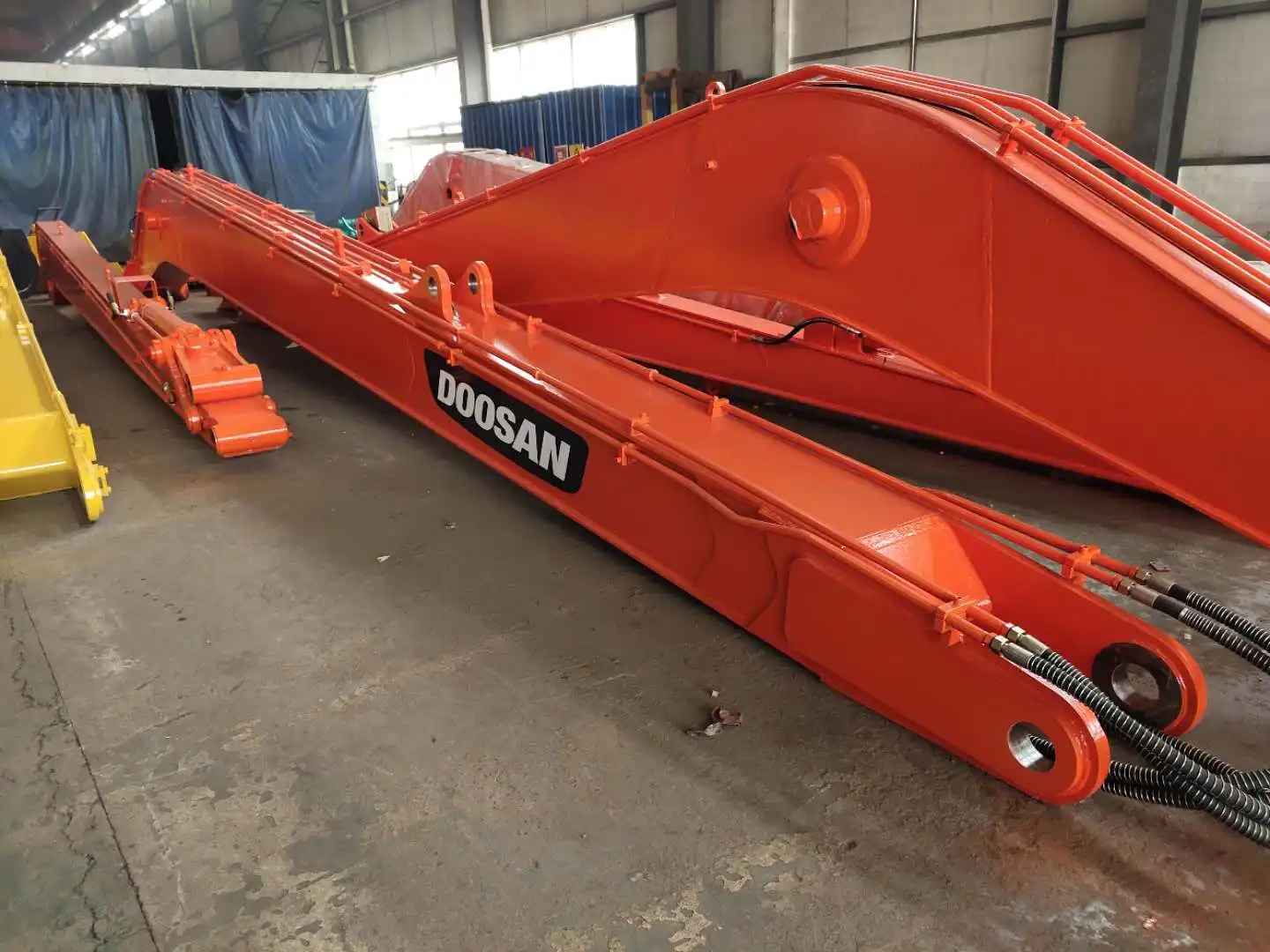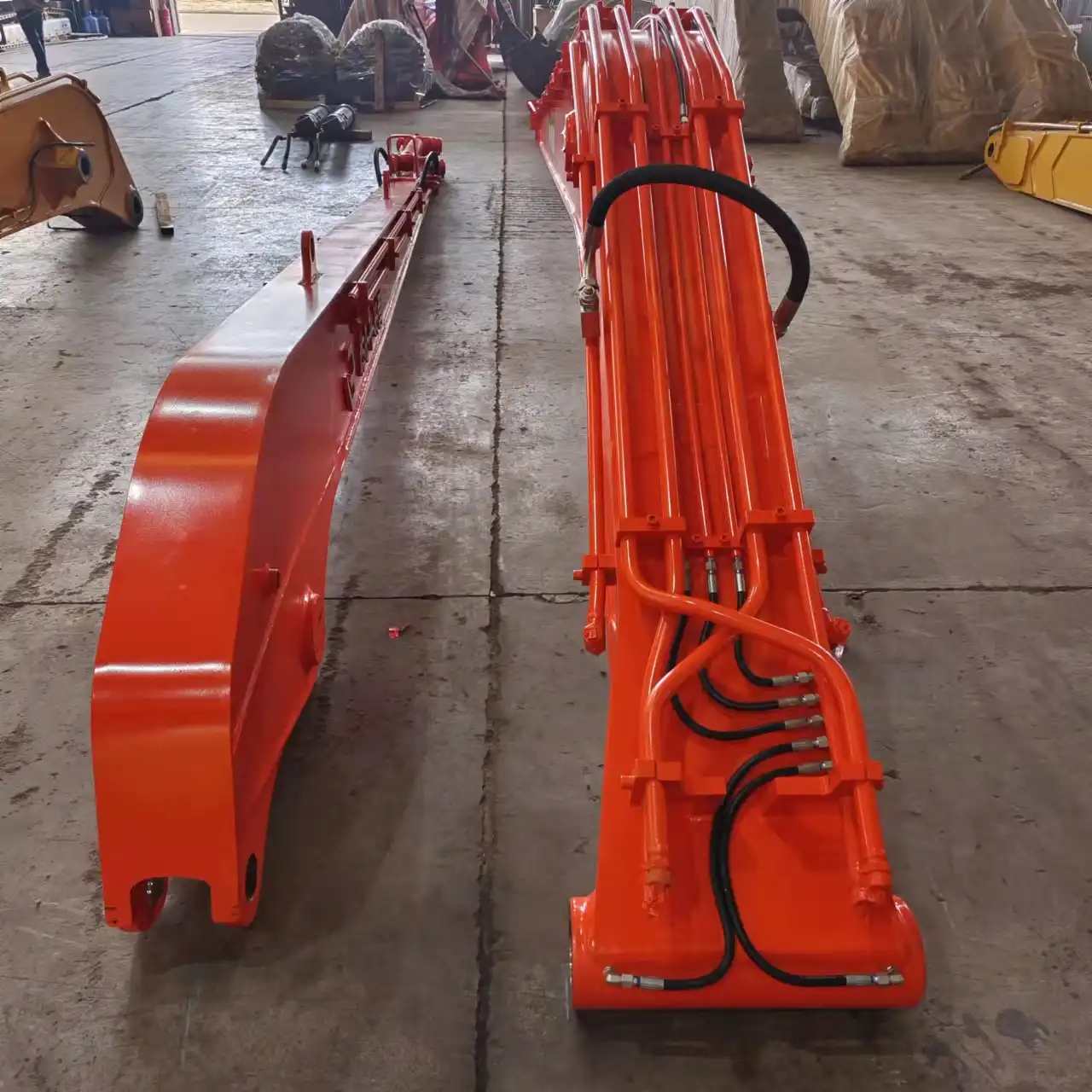Standard VS Long Boom Excavator Reach Arm
When choosing between standard and long boom excavator configurations, understanding their fundamental differences becomes crucial for project success. A standard excavator arm typically extends 8-12 meters, while a long boom excavator reach arm can reach distances up to 25 meters, dramatically expanding operational capabilities. The choice between these two options directly impacts project efficiency, safety protocols, and overall construction costs. Standard arms excel in confined spaces and general construction tasks, offering superior maneuverability and faster cycle times. Meanwhile, long reach arms revolutionize specialized applications like high-rise demolition, deep excavation projects, and waterway maintenance where extended reach proves essential. The structural complexity, hydraulic requirements, and operational considerations vary significantly between these configurations, making informed selection vital for contractors, mining operations, and railway maintenance teams who demand optimal equipment performance for their specific applications.

Operating Range
Reach Distance Capabilities
The most apparent distinction between standard and extended reach configurations centers on operational distance. Standard excavator arms deliver reliable performance within an 8-12 meter radius, making them ideal for routine construction tasks, utility installations, and general earthmoving operations. These conventional setups provide excellent precision for detailed work, allowing operators to maintain close control over bucket positioning and material handling.
Conversely, long boom excavator reach arm systems revolutionize accessibility by extending operational ranges up to 25 meters. This extended capability opens possibilities for projects previously requiring multiple equipment setups or specialized access solutions. Deep foundation work, riverbank stabilization, and elevated demolition projects become significantly more manageable with extended reach capabilities.
Vertical Working Heights
Vertical reach represents another critical operational parameter where these configurations diverge substantially. Standard arms typically achieve working heights of 10-15 meters above ground level, sufficient for most conventional construction applications. However, projects involving multi-story structures, bridge maintenance, or industrial facility work often demand greater elevation access.
Extended reach systems excel in vertical applications, comfortably accessing heights exceeding 20 meters while maintaining operational stability. This capability proves invaluable for demolition contractors tackling high-rise structures, utility companies maintaining elevated infrastructure, and mining operations requiring precise material placement at various elevations.
Workspace Flexibility
Operational flexibility varies dramatically between these configurations, influencing project planning and execution strategies. Standard arms offer superior maneuverability in confined spaces, enabling efficient work in urban environments, residential areas, and congested construction sites. Their compact design facilitates quick repositioning and reduces setup time between operations.
Extended reach configurations sacrifice some maneuverability for specialized access capabilities. While they excel in reaching remote or elevated locations, operators must carefully plan movements to accommodate the extended arm's spatial requirements. This trade-off becomes particularly relevant when working near overhead obstacles or within restricted jobsite boundaries.

Structural Design
Boom Section Configuration
The fundamental structural approach differs significantly between standard and extended reach designs. Standard excavator arms utilize a two-section boom configuration, incorporating a main boom and stick assembly that provides robust performance for general applications. This simplified design minimizes potential failure points while maintaining excellent strength-to-weight ratios essential for everyday construction tasks.
Long boom excavator reach arm systems employ multi-section designs, typically featuring three or more boom segments connected through precision-engineered pivot points. Each additional section increases complexity but enables the remarkable reach extensions that define these specialized attachments. Advanced engineering ensures smooth power transmission throughout the extended structure while maintaining operational precision.
Material Composition and Strength
Material selection and structural reinforcement represent critical design considerations where these configurations diverge. Standard arms utilize high-strength steel construction optimized for durability and cost-effectiveness. The shorter length allows for lighter construction without compromising lifting capacity or operational reliability, making them ideal for continuous operation across diverse applications.
Extended reach systems require specialized high-strength steel alloys and reinforced construction techniques to handle the increased leverage forces generated by extended positioning. Additional structural bracing, thicker wall sections, and strategic reinforcement points ensure safe operation at maximum extension while preventing structural fatigue during prolonged use.
Hydraulic System Integration
Hydraulic system design complexity increases substantially with extended reach configurations. Standard arms utilize straightforward hydraulic circuits with minimal pressure loss between pump and actuators. This direct power delivery ensures responsive operation and efficient fuel consumption, critical factors for contractors managing operational costs.
Extended reach systems incorporate advanced pressure-compensated hydraulic circuits designed to maintain consistent performance across the extended boom structure. Multiple hydraulic lines, pressure regulation systems, and specialized valving ensure adequate power delivery to remote attachment points while preventing system overload during demanding operations.

Load Capacity
Maximum Lifting Capabilities
Load capacity represents a fundamental performance parameter where standard and extended reach configurations demonstrate distinct characteristics. Standard excavator arms typically maintain their rated lifting capacity throughout most of their operating envelope, providing consistent performance for material handling, lifting operations, and precision placement tasks. This reliability makes them preferred choices for general construction where predictable lifting capacity ensures safe, efficient operations.
Long boom excavator reach arm systems experience capacity reduction as extension increases due to leverage physics. While base models may handle similar loads to standard configurations, maximum extension points typically reduce lifting capacity to approximately 3 tons. Understanding these limitations becomes crucial for project planning, particularly when selecting equipment for specific lifting requirements.
Stability Considerations
Machine stability varies significantly between these configurations, directly impacting safe operating practices and productive capacity. Standard arms maintain excellent stability throughout their operating range, allowing operators to work confidently near maximum capacity without excessive concern for tip-over conditions. This stability advantage translates to faster cycle times and reduced operator stress during demanding operations.
Extended reach configurations require enhanced stability awareness due to the increased moment arm created by extended positioning. Operators must carefully monitor load conditions, ground stability, and machine positioning to maintain safe operating margins. Modern systems incorporate load sensing technology and stability monitoring to assist operators in maintaining safe working conditions.
Dynamic Load Management
Dynamic load handling capabilities distinguish these configurations in operational environments. Standard arms excel in rapid material handling applications where quick acceleration and deceleration cycles are common. The shorter boom structure minimizes dynamic forces, enabling aggressive operational patterns without compromising safety or equipment longevity.
Extended reach systems require more deliberate load handling techniques to prevent structural stress and maintain operational safety. Smooth acceleration patterns, controlled movement speeds, and careful load positioning become essential operational practices. While this may reduce cycle times compared to standard configurations, the specialized access capabilities often justify these operational considerations.
FAQ
Q: What projects benefit most from long boom excavator reach arm configurations?
A: Extended reach arms excel in demolition projects, deep excavation work, waterway maintenance, and any application requiring access to elevated or remote locations beyond standard equipment capabilities.
Q: How does fuel consumption compare between standard and extended reach configurations?
A: Extended reach systems typically consume 15-25% more fuel due to increased hydraulic system complexity and the additional power required to operate extended boom sections.
Q: Can extended reach arms be used for general construction tasks?
A: While possible, extended reach arms are less efficient for routine construction due to reduced maneuverability and slower cycle times compared to standard configurations.
Q: What maintenance differences exist between these configurations?
A: Long boom excavator reach arm systems require more frequent hydraulic system maintenance and additional lubrication points due to increased complexity and component count.
Choose Tiannuo's Advanced Long Boom Solutions
Tiannuo's long boom excavator reach arm technology delivers exceptional performance with maximum reach capabilities up to 25 meters. Our high-strength steel alloy construction ensures durability while advanced pressure-compensated hydraulic systems maintain consistent power delivery throughout the extended structure.
Compatible with excavators ranging from 20-50 tons, our modular designs offer lift capacities up to 3 tons at full extension. Whether you're tackling demolition projects, deep excavation work, or specialized lifting applications, Tiannuo's engineering excellence provides the reliability and performance your operations demand.
Ready to expand your excavator's capabilities? Contact our technical specialists at raymiao@stnd-machinery.com to discuss customized solutions for your specific project requirements. Our team will help you select the optimal configuration to maximize productivity while ensuring safe, efficient operations.
References
1. Construction Equipment Magazine. "Hydraulic System Design Principles for Extended Reach Excavators." Industrial Machinery Review, 2024.
2. Thompson, R.J. "Structural Analysis of Multi-Section Boom Configurations in Heavy Construction Equipment." Journal of Construction Engineering, 2023.
3. International Association of Equipment Manufacturers. "Load Capacity Standards for Extended Reach Excavator Attachments." IAEM Technical Publication, 2024.
4. Martinez, C.L. "Operational Efficiency Comparison: Standard versus Long Boom Excavator Configurations." Heavy Equipment Operations Quarterly, 2023.
5. European Construction Equipment Association. "Safety Guidelines for Extended Reach Excavator Operations." ECEA Safety Standards Manual, 2024.
About Author: Arm
Arm is a leading expert in the field of specialized construction and railway maintenance equipment, working at Tiannuo Company. Tiannuo specializes in manufacturing a wide range of products, including railway maintenance equipment like railway sleeper changing machines and screening machines, excavator modification equipment such as excavator lifting cabs, various engineering arms for excavators, excavator accessories like digging buckets, and engineering vehicle auxiliary equipment like loader buckets.

